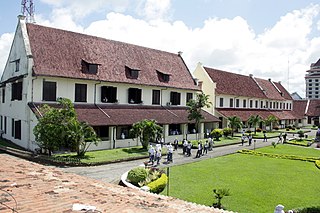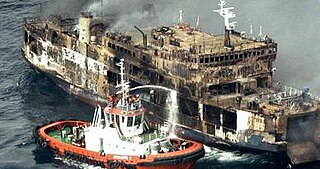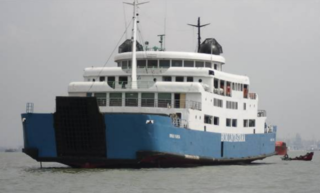
Makassar is the capital of the Indonesian province of South Sulawesi. It is the largest city in the region of Eastern Indonesia and the country's fifth-largest urban center after Jakarta, Surabaya, Medan, and Bandung. The city is located on the southwest coast of the island of Sulawesi, facing the Makassar Strait.

Permesta was a rebel movement in Indonesia, its name based on the Universal Struggle Charter that was declared on 2 March 1957 by civil and military leaders in East Indonesia. Initially the center of the movement was in Makassar, which at that time was the capital of the province of Sulawesi. However, support for the movement in South Sulawesi gradually dissipated, forcing the headquarters to move to Manado in North Sulawesi.

Pelni is the national cargo and passenger shipping company of Indonesia. Its services network spans across the Indonesian archipelago. Mainly serving as connector between bigger cities and to remote islands, Pelni plays an important role in the Indonesian transport system.

The Levina 1 was an Indonesian passenger ferry. On 22 February 2007, it caught fire, killing at least 51 people. Three days later, on 25 February, it sank with a group of journalists and investigators on board, killing at least one more and leaving three missing.

A lifeboat or liferaft is a small, rigid or inflatable boat carried for emergency evacuation in the event of a disaster aboard a ship. Lifeboat drills are required by law on larger commercial ships. Rafts (liferafts) are also used. In the military, a lifeboat may double as a whaleboat, dinghy, or gig. The ship's tenders of cruise ships often double as lifeboats. Recreational sailors usually carry inflatable liferafts, though a few prefer small proactive lifeboats that are harder to sink and can be sailed to safety.

Literally, the word pinisi refers to a type of rigging of Indonesian sailing vessels. A pinisi carries seven to eight sails on two masts, arranged like a gaff-ketch with what is called 'standing gaffs' — i.e., unlike most Western ships using such a rig, the two main sails are not opened by raising the spars they are attached to, but the sails are 'pulled out' like curtains along the gaffs which are fixed at around the centre of the masts.

Xpress Air was a domestic regular airline that offered direct flights to the eastern parts of Indonesia, with its first flight in 2005, and from 2014 international routes to Malaysia. Beginning with two Boeing 737s, Xpress Air was the first privately owned, scheduled airline to connect Jakarta to 24 domestic destinations like Makassar, Ternate, Sorong, Manokwari and Jayapura. Makassar was a main hub for all flights coming from Java to the eastern cities of Indonesia, while Sorong was a second hub in Papua, connecting remote places surrounding the West Papua area. The airline ceased all operations in 2021.

The sinking of MV Teratai Prima occurred on January 11, 2009, around 04:00 local time when a ferry carrying more than 300 people capsized in the Makassar Strait off West Sulawesi, Survivors stated that the ferry had been slammed by 4-metre (13 ft) waves twice. The first one hit so hard that the ship became unbalanced, before another wave hit from a different direction and sank the vessel.

Fort Rotterdam is a 17th-century fort in Makassar on the island of Sulawesi in Indonesia. It is a Dutch fort built on top of an existing fort of the Gowa Kingdom. The first fort on the site was constructed by the a local sultan in around 1634, to counter Dutch encroachments. The site was ceded to the Dutch under the Treaty of Bongaya, and they completely rebuilt it between 1673 and 1679. It had six bastions and was surrounded by a seven meter high rampart and a two meter deep moat.
2016 (MMXVI) was a leap year starting on Friday of the Gregorian calendar, the 2016th year of the Common Era (CE) and Anno Domini (AD) designations, the 16th year of the 3rd millennium and the 21st century, and the 7th year of the 2010s decade.
Andi Muhammad Ghalib was an Indonesian Military officer, politician, and diplomat. He served as the Attorney General of Indonesia from 1998 to 1999 within the Development Reform Cabinet of President B. J. Habibie. Ghalib resigned as Attorney General in June 1999 amid a corruption scandal.

Ir. Freddy Jaques Inkiriwang was a former Indonesian Minister of Industry in the Djuanda Cabinet. He received an Ingenieur degree in electrical engineering from at the Delft University of Technology in 1937. After the Proclamation of Indonesian Independence, Inkiriwang was involved in the formation of the state electricity company and the independence struggle in Sulawesi. After the establishment of the Bureau of Electricity and Gas on 27 October 1945, Inkiriwang was assigned to head the West Java region. He was also appointed as head of development in the Sulawesi Commissariat organization in Jakarta to assist the struggle in Sulawesi.

The sinking of MV Marina Baru 2B occurred just after noon on 19 December 2015. The high speed vessel carrying 112 passengers and crew sank off the coast of Bone, South Sulawesi in inclement weather conditions. A nine-day search and rescue operation, conducted by authorities, successfully rescued 45 survivors and recovered 65 bodies from the sea. Twelve people were declared missing and presumed dead.

MV Lestari Maju was a modified 749 tonnes cargo ship that operated domestic passenger service from Bulukumba Regency to Selayar Islands in South Sulawesi. At noon on 3 July 2018, the ship was deliberately grounded off the Selayar Islands. The ferry had reportedly suffered a leak on the port side of the lower deck. As the ferry began to sink, the captain decided to ground the ferry to stop the sinking and ease the rescue effort. The incident killed 35 people; 155 people survived the accident.

The Zahro Express disaster occurred on the morning of 1 January 2017 when an Indonesian-flagged wooden passenger vessel caught fire in the waters of Thousands Islands Regency, off the coast of Jakarta. She was travelling from Jakarta's Muara Angke to Tidung Island, a popular tourist destination. The ferry, named MV Zahro Express, was carrying 216 passengers and 5 crew members. Of the 221 passengers and crews, a total of 24 people on board lost their lives.

MV Laut Teduh II was an Indonesian-flagged double-ended RO/RO passenger ferry that served the route from the Port of Merak in Java to the Port of Bakauheni in Sumatra, one of the busiest ferry routes in Indonesia. She was built in 1988 in England and was registered as Laut Teduh II in 2007.
Malkan Amin was an Indonesian politician who represented both the Golkar and NasDem parties.

MV. Windu Karsa was an Indonesian-flagged double-ended RO/RO ferry that served the route from Luwu, South Sulawesi to Kolaka, Southeast Sulawesi. Built in Fujiwara Shipyard in 1980, she has served in Indonesia for more than 20 years.















